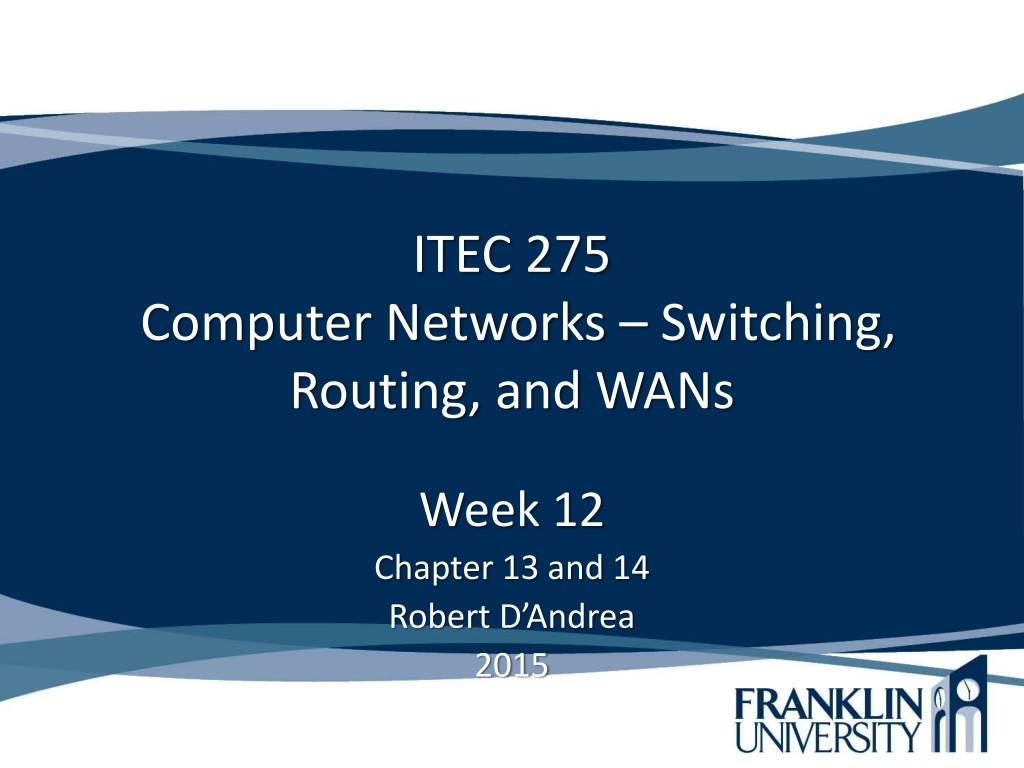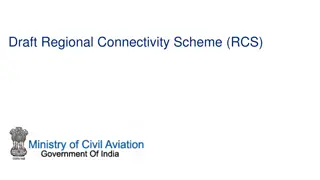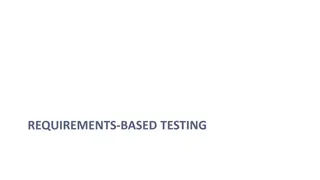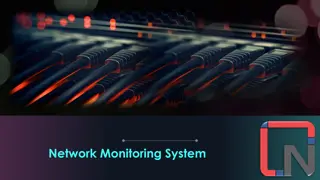Network Testing for Efficient Connectivity
Today, network connections play a vital role in both home and company environments. Ensuring a stable and fast network connection is essential for optimal performance. Various network testing tools are available, including LAN Speed Test and Internet Speed Tracker Extension, to help assess and improve network connectivity.
Download Presentation

Please find below an Image/Link to download the presentation.
The content on the website is provided AS IS for your information and personal use only. It may not be sold, licensed, or shared on other websites without obtaining consent from the author.If you encounter any issues during the download, it is possible that the publisher has removed the file from their server.
You are allowed to download the files provided on this website for personal or commercial use, subject to the condition that they are used lawfully. All files are the property of their respective owners.
The content on the website is provided AS IS for your information and personal use only. It may not be sold, licensed, or shared on other websites without obtaining consent from the author.
E N D
Presentation Transcript
ITEC 275 Computer Networks Switching, Routing, and WANs Week 12 Chapter 13 and 14 Robert D Andrea 2015
Agenda Learning Activities Network testing Benchmark comparison testing Building a prototype network system - Review parts of Chapter 13 - Testing your network - Documenting network systems Areas of Interest - Response to RFP - Contents of Network Document - Network Design Testing
Network Testing Today, most all computers have a network connection of some description. This could be to an Internet Service Provider (ISP), or to an Ethernet connection to a company intranet, sending and receiving data bi-directionally to other computers which might be an essential daily procedure. With the myriad of applications available, the use of TCP/IP networking, email, web browsers and games are in use on a regular basis, just to name a few popular ones. In all cases, the one performance factor the user is most concerned with is speed or transfer rate and security.
Network Testing Network connections are very common in todays environment. These connections are utilized in company environments and at home because of the affordable broadband connection made available by our ISP. Setting up a local area network is so much easier today thanks to the multiple port router where all you need is just plug in the network cable and it will work right after going through a simple wizard configuration. Even wireless connections can be quickly and easily established by pressing the WPS button that is found on most newer generation routers.
Network Testing Whether you are a computer technician, software engineer, teacher or just an every day user, it is important to make sure that your network connection is working properly in order to achieve the fastest file download or transfer speed and a stable connection for streaming purposes. The availability of many of these tools is plentiful. Many network testing tools are free. The open source community has provided many different types of network testing applications.
Network Testing Internet Speed Tracker Extension (Chrome browser). Includes a History display.
Network Testing 1. LAN Speed Test
Network Testing 1. LAN Speed Test is used to measure the speed on your LAN by copying a file to another computer that is located at the same local network. All you need to do is browse the location of another computer on the network where you have write access and click the Start Test button. You will then be prompted to set the file size of the dummy file to be transferred. One advantage of using this tool, you do not need to setup a master and client connectivity. This tool provides a Print Results button for printing the results at the end of the test. LAN Speed Test Look@LAN Network Monitor
Network Testing 2. LANBench Test
Network Testing 2. LANBench Test is a tool only to be used to test TCP. This tool requires the computers to be configured as a client server model. The client computer will be the tester. The role of the server is to press the Listen button. The client side requires a bit more configuration setup, the servers IP address. Tests can be setup to define the test duration, packet size, connection and transfer mode. What is interesting to watch with this tool is to see the live transfer rate and average performance indicators. www.zachsaw.com/pg=lanbench_tcp_network_benchmark
Network Testing 3. NetIO-GUI
Network Testing 3. NetIO-GUI is a command line application for benchmarking the network throughput and there is a portable GUI version that works as a frontend. After downloading, run the extractor, followed by running NetIO-GUI.exe. You will also need to run NetIO-GUI on both computers that you want to test, one as client- mode and the other as server-mode. The server will only require to click on the Start server button while for the client, you will need to input the server s IP address and optionally select the protocol (TCP or UDP) that you want to test. NetIO-GUI will then test the connectivity based on a few different packet size.
Network Testing www.softpedia.com/get/PORTABLE- SOFTWARE/Network/NetIO-GUI-Portable.shtml NetIO-GUI Portable is a simple software tool which enables you to measure the ICMP responses and network transfer rates and save results to a file.
Network Testing 4. NetStress Test
Network Testing 4. NetStress is considered an internal tool. It requires both computers that want to test to be downloaded with this software. This tool automatically determines the receiver IP address. In order to use this tool for testing and troubleshoot networks, you need tools that allow for the generation of network traffic and analyze the network s throughput performance. Nutsaboutnets.com/netstress/
Network Testing 5. AIDA32 Test
Network Testing 5. AIDA32 is the popular hardware information and benchmarking tool known as EVEREST. Currently, there is an AIDA64 version. Just like most of the network benchmarking tools, you need to run the network benchmark plugin on both computers that you want to test. On one computer, select Master from the drop down list located at the bottom of the window, go to the Bandwidth tab and click on the Start button. On another computer, select Slave, enter the IP address of the Master, go to Bandwidth tab and click Start. The Save button allows you to save the bandwidth chart in bitmap format
Network Testing www.softpedia.com/get/System-Info/AIDA.shtml
Network Testing 6. Performance Test
Network Testing 6. Performance Test by PassMark is a network benchmarking tool. It can test both IPv4/IPv6 and allowing you to set the data block size and enable UDP bandwidth throttling. PassMark Performance Test allows you to objectively benchmark a PC using different speed tests and compare those results to other computers. www.passmark.com/products/pt.htm
Benchmark Comparison Testing Reasons for benchmarking systems is to capture data in certain configurations where you have: Low latency High performance Data integrity High efficiency Less jitter
Building a Network System Building a network computer lab or prototype. View video: https://www.youtube.com/watch?v=dIFKmJ4wufc
Document Network System A design document describes your customer s requirements and explains how your new design is going to meet their requirements. The design document includes the existing network, the logical and physical design, and budget and expenses associated with the new project. A design document includes plans for implementation of the network, and evolving the network design as the company grows. It is important to include that the network design is an iterative process. Steps are always being taken to optimize network performance.
Document Network System A Request for Proposal (RFP) details the customer s design requirements and the types of solutions a network design should include. An RFP is sent to vendors and consultants to select the correct vendor. Sending RFPs to vendors is an excellent way to initiate competitive design comparisons, availability of products, pricing, service, and support arrangements.
Typical RFP Categories Business goals Scope of project Existing network and applications New applications Technical requirements Warranty Environment constraints that could affect implementation Training Schedules and timelines Legal contractual terms and conditions
RFP Format Customer s prescribed format and structure - Reason might be that customer expects a response to fit into a certain format (follow-up document) - Some RFPs are in the form of a questionnaire
No RFP Response Format Network topology Information on protocols, technologies, and products Implementation plan Training plan Support and service plan Prices and payment arrangement Qualifications of vendor Testimonials from other customers Legal contractual terms and conditions
RFP Conclusion Highlight the use of ingenuity to ensure your response benefits your network design Predict what your competition will do to out maneuver your new network design. Each requirement in the RFP should correspond to the content (one-for-one correspondence) of the RFP.
Content of a Network Design Executive Summary states the major points of the document Project Goal business goal brief enough to convey the overall objective of the company Project Scope details the extent of the project. What departments and areas will be impacted by the project. Design Requirements lists all the major business and technical requirements for the network design. The company goals would be listed in priority order.
Content of a Network Design 1. Business goals explain the role the network design will play in helping an organization provide better products and services to its customers. 2. Technical goals should be regularly demonstrated through tests or prediction.
Technical Goals Reflected in Testing Scalability is growth a network design must support Availability available for users MTBF and MTTR Network performance customer s criteria of acceptance (throughput, delay, response time) Security general and specific goals to protect company information Manageability of performance, fault, configuration, security, and accounting management Usability ease of use by user community Adaptability to network failures and its services Affordability containing costs associated with purchases The technical goals should also include any tradeoffs the customer is willing to make.
Technical Goals Reflected in Testing User Communities and Data Stores - List major user communities, their sizes, locations, and the principal applications they use. Network Applications - Characterizes new and existing network applications.
Evaluating an Existing Network Document - Structure of existing network - Logical design should include drawings, naming convention, protocols, addressing, network management - Physical design should describe the features and recommended uses for the technologies and devices. Include pricing for all hardware and software. -Applications to be used on system -Analysis of the health and performance
Evaluating an Existing Network Evaluate existing networks. View video: https://www.youtube.com/watch?v=zbq4qiL5bG8
Network Design Testing Testing objectives Test acceptance criteria Testing tools Text scripts Results and observations The customer should be informed on how the results were determined, through component or live or prototype network testing, load factors applied during testing.
Network Design Testing Types of tests Application response-time tests Throughput tests Availability tests Regression tests
Implementation Plan The Implementation Plan should include recommendations for deploying network design. Details of plan are dependent on the audience - IS department will want a very detailed plan - Sale engineer brief summary of network products - Upper management will not be interested in the technical details, as much as cost and return on investment.
Implementation Plan Project schedule Plans for installation of links, equipment, or services. Outsourcing or management of the network Plan to communicate design to user community, network administrators and management Training for network managers and users Plan to baseline effectiveness of new design List of known risks that could delay the project Fallback plan if failure occurs Plan to evolve network design as new applications arise
Implementation Plan The Implementation Plan should include a project schedule or timeline. This schedule should include dates and deliverables for major events.
Project Budget Document This document should list the money available for equipment, maintenance, service contracts, training, and staff. In addition, include the a Return-On-Investment analysis. Most customers feel better after observing the investment savings.
Document Appendix Store supplemental information - Topology maps - Device configurations - Network addressing - Naming convention - Results from testing network design
Summary If the customer provides an RFP - Follow the format presented - Otherwise, develop a document that describes requirements, existing network, logical and physical design, budget, and expenses associated with the network design. Executive Summary Primary project goals Network topology Addressing and naming convention Test results Plan for implementing and measuring performance, security, manageability, usability, and availability.
This Weeks Outcomes Network Design Testing Benchmark Comparison Testing Document Your Network Design Guidelines for RFP Document Content Technical Goals Reflected in Testing Document Appendix
Due this week 13-1 Concept questions 11
Next week Review chapter 14 in Top-Down Network Design
Q & A Questions, comments, concerns?
























